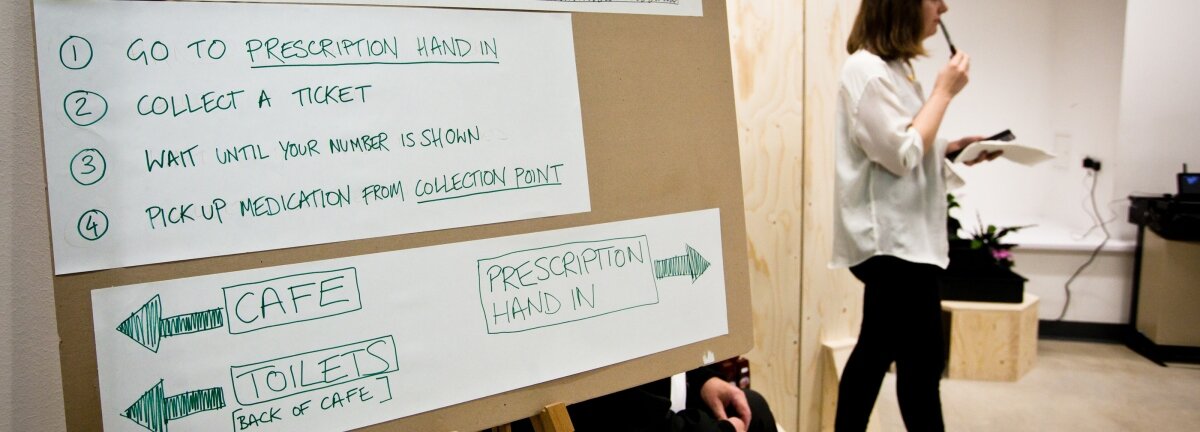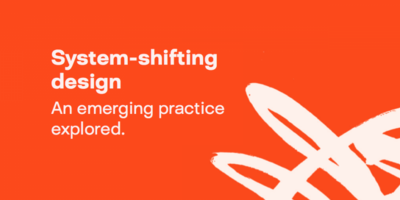Whittington Hospital Pharmacy

The key thing for me was the way we were able to engage patients during the live process. Once we started doing the prototyping, we got so much feedback. It was completely different from the questionnaire process.
Dr Helen Taylor, Chief Pharmacist, Whittington Hospital
The Whittington Hospital collaborated with designers, architects and their own patients to discover how best to use space and redefine the user experience of its pharmacy.
Ambition
The Whittington Hospital is one of the UK’s busiest hospitals employing 4,000 staff who provide care for more than 500,000 people across north London.
Chief Pharmacist, Dr Helen Taylor, knew that collecting a prescription was not a pleasant experience for her patients. They entered the pharmacy often feeling unwell and anxious; feelings only exacerbated by long waiting times and lack of communication.
Previous efforts to improve the situation, such as user questionnaires, had resulted in poor levels of patient participation and yielded no clear insights. However, Dr Taylor felt sure the answer lay with design; she turned to Design Council's public services transformation programme to see how they could support the service delivery.
What we did
Over a year, Design Council Design Associates Anna White and Sean Miller worked closely with Whittington pharmacy to analyse the service and pinpoint areas where improvements could be made. Eventually a shared definition of the problem was agreed, and the team identified three key actions to address:
- Improve the experience for patients
- Use every intervention as a health promotion opportunity
- Develop a retail offer to offset expenditure
Using the findings, the team turned these priorities into a detailed design brief. The Design Council then helped the Whittington pick two design agencies to work with: architectural codesign experts Studio TILT, and service design agency commonground.
The collaborative approach we took to designing the pharmacy was about encouraging those involved to explore the role of objects, furniture and design in their space and its impact on their own day and behaviour. Our aim was to improve the pharmacy experience for all those who use it.
Oliver Marlow, Creative Director, Studio TILT
The codesign approach meant the designers’ focus was on allowing pharmacy users to collaboratively create a space that would work best for them. This began by establishing a programme of workshops with representatives from patient, staff and management groups. Together they came up with new ideas for how the space could work, then tested and retested ideas, first in model form, then at half scale, and finally at full scale within the pharmacy itself.
Patients provided real-time feedback and responses as they interacted with the new prototype elements in the pharmacy.
The Results
The project has measurably improved the patient experience at the Whittington, boosted staff morale and increased sales at the pharmacy. Importantly for the hospital, it has also produced a design model that can be applied to other spaces within its walls, and a willingness to experiment.
Having an internal champion who really understood the process, in this case Dr Helen Taylor, was central to the success of the project. Hospitals are naturally risk-averse environments; however Helen’s ability to navigate internal hospital politics and convince staff to engage with the codesign process gave the project credibility and the space to thrive.
The Whittington Hospital subsequently invited Studio TILT back to work on a further project using the same codesign process to help create a major new Ambulatory Care Centre, this time with architects Levitt Bernstein.
Dr Taylor attested to the legacy of working with Design Council and learning about the power and value of codesign: “As we get funding for different bits, we implement them. The hospital’s management team feels strongly that we should just push work like this through because it has such a good effect on patients.”
Subscribe to our newsletter
Want to keep up with the latest from the Design Council?

